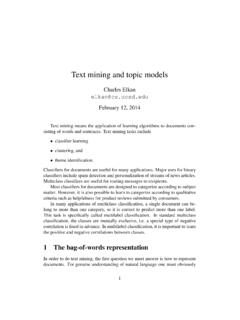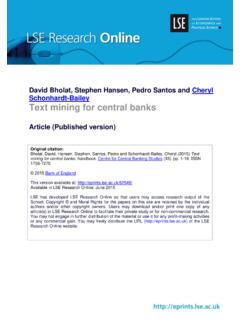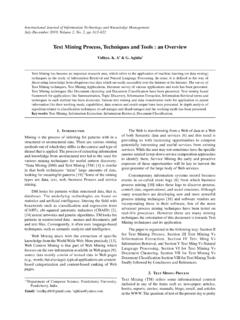Transcription of Text Mining in JMP with R
1 Text Mining in JMP with R Andrew T. Karl, Senior Management Consultant, Adsurgo LLC Heath Rushing, Principal Consultant and Co-Founder, Adsurgo LLC 1. Introduction A popular rule of thumb suggests that 80% of data in most organizations is unstructured, such as text. Text Mining is the process of finding interesting and relevant information from this unstructured data and determining if there are any meaningful relationships by transforming it into a structured format and applying classical multivariate statistical techniques. Many companies use this methodology on a daily basis for pattern discovery ( warranty analysis , electronic medical records analysis ) and predictive modeling ( insurance fraud) using text from various sources such as email, survey comments, incident reports, free form data fields, websites, research reports, blogs, and social media.
2 For these frequent users, SAS offers a comprehensive text Mining tool, SAS Text Miner. However, the infrequency of use in some organizations does not warrant the cost associated with this software. For example, some organizations within the Department of Defense need a basic, low-cost text Mining capability to augment their existing analytical suite of tools: the US Army requires periodic text Mining in their operational analysis of improvised explosive devices (IEDs). Additionally, the US Air Force requires occasional text Mining to find information from pilot comments from operational tests. For such organizations, a JSL script accessing the R language offers a viable, low-cost alternative. This paper highlights how text Mining capabilities furnished by the R language may be wrapped into a JMP JSL script.
3 R is an open source language for statistical computing. A variety of add-on packages may be downloaded from the Comprehensive R Archive Network (CRAN) to supplement the base R system. Using these packages (such as tm ), R is capable of gathering a collection of documents into a corpus and then building a document term matrix from that corpus. R also supports sparse matrix algebra, which is necessary for text Mining . We refer readers elsewhere for a detailed description of the principles of text Mining , also known as natural language processing. A nice introduction to text Mining is provided by Weiss, S., et al. (2009) Text Mining : Predictive Methods for Analyzing Unstructured Information. We will illustrate our script with a data set on National Transportation Safety Board (NTSB) airplane accident reports provided by Miner, G.
4 , et al. (2012) Practical Text Mining and Statistical analysis for Non-structured Text Data Applications. We will assume a basic knowledge of these topics and focus on presenting these capabilities through JMP with R. 2. What is text Mining ? By text Mining , we refer here to the process of reducing a collection of documents (also known as a corpus) into a document-term matrix (DTM), with one row for each document and one column for each word that appears in the corpus. Once represented in this form, the corpus may be analyzed using existing data- Mining methods ( with some modifications), treating documents as observations and words as variables. This bag-of-words approach assumes that the order that the words in a document appear in, as well as their parts of speech, may be ignored.
5 A major challenge in text Mining problems is that the DTM is often extremely large; however, due to the relatively infrequent occurrence of most words, the DTM is also sparse, allowing it to be stored efficiently. In some applications, there are more terms present in a corpus than documents, causing problems for some model building routines. Even in cases where there are more documents than terms, the large number of terms will slow down the model building process for some procedures. Since many of the terms are likely to be irrelevant, the larger number of irrelevant terms will increase the variance of the estimates. A rank-reduced singular value decomposition (SVD) may be applied to the DTM to produce a matrix with fewer columns.
6 For example, a DTM with ten thousand words may be reduced to a matrix with only 50 columns. These 50 columns are formed by taking linear combinations of the original 10,000 columns in a way that preserves as much of the original information as possible. The smaller matrix resulting from the SVD is produced by default with our JMP script. While the DTM may be used directly with either supervised or unsupervised learning methods ( with some special modifications to standard methods), importing this matrix into JMP would require that it be treated as a dense matrix, which is not feasible for larger applications (though this option is provided by the script). In some cases, it may be important to be able to predict responses for future observations.
7 For example, a logistic regression may be used to predict whether or not an insurance claim is fraudulent based on the written report filed by the agent. This model would depend on vectors from the SVD of the DTM resulting from the training corpus of claims. Special care must be taken when handling new observations: they need to be transformed to the space spanned by the SVD on the training data. Popular text Mining questions include, which documents are most similar? and, which documents are most similar to this particular document? There are a couple major advantages of using vectors from the SVD of the DTM rather than the DTM itself to answer these questions. First, the DTM is usually large enough that it cannot be manipulated without accounting for its sparse structure.
8 JMP does not offer this capability. Secondly, the entries of the DTM are non-negative, and we are more concerned about overlap of positive entries (shared words between two documents) than we are about overlap of zero entries (words that are absent from both of two documents). This requires the use of the cosine metric, which is not available within the JMP Cluster platform. By contrast, the document summaries resulting from the SVD may be analyzed with the Euclidean metric. A third advantage is that the dimensionality reduction provided by the SVD eliminates redundant/irrelevant variables that can often cause problems with clustering algorithms. Just as documents may be clustered, the output of the SVD may be used to cluster terms.
9 This can detect which words occur commonly together throughout the corpus. More details about the SVD appear in the Appendix. The ability to perform text Mining in JMP should provide opportunities to explore columns of unstructured text information that would otherwise be ignored. The visual exploration of summaries of a collection of documents including latent semantic analysis , raw counts, and clustering on the documents and terms provides a low-cost ability to search for new patterns and identify previously unknown relationships in your data. Thanks to the efficient routines for text Mining and matrix algebra provided by R, this JMP script scales well to large collections of long documents. 3. JMP Script and Application To illustrate our script, we will analyze a collection of NTSB accident reports that are available from Miner, G.
10 , et al. (2012) Practical Text Mining and Statistical analysis for Non-structured Text Data Application. The accident reports contain columns of structured information along with columns of unstructured text. The structured information includes the time and location of the accident, as well as whether there were any fatalities. The text columns contain the written accounts of the accidents along with succinct descriptions of the causes of the accidents. For our text Mining examples, we will focus on the column narr_cause, which contains the equivalent of 209 single-spaced pages ( with one blank line between each report) using Times New Roman 12 point font. There are a total of 84370 words, with an average of 26 words/report for 3235 reports.










